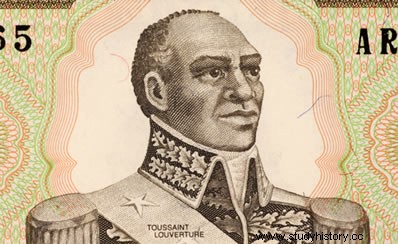
By Tales Pinto
The Independence of Haiti of the French metropolis took place in 1804, after a bloody battle on the Antillean island, in which the white population was exterminated by the slaves who had revolted. In addition to becoming the first independent country in the Americas, Haiti was also the first country to abolish slavery from its borders.
The adoption of the ideals of Liberty, Equality and Fraternity by the rebels and the radicality of the actions in the struggles for independence led the leaders of the movement to be known as Black Jacobins, in allusion to the group that commanded the National Convention, during the French Revolution, between 1792 and 1795.
Called as the island of Santo Domingo, the region had been conquered by Europeans shortly after the arrival of Christopher Columbus in 1492 – the Genoese conqueror had christened the island Hispaniola. The native population was exterminated from the island, and slave labor was adopted in the 16th century for the production of tropical products to feed the colonial market, mainly the production of sugar. The island of Santo Domingo began to be occupied, in its western portion, by the French at the end of the 17th century and, in 1697, a treaty between the Spanish and French guaranteed the possession of the place for the latter. From then on, it would become the main source of wealth for French colonial exploration, producing various goods, especially sugar. São Domingo produced almost two-thirds of the world's traded sugar in the decades leading up to the independence process.
To produce such a large amount of this commodity, a contingent of approximately five hundred thousand slaves was maintained on the island's plantations. The white population, made up of owners and administrators, numbered 35,000 people. There was still a small contingent of mulattos and ex-slaves who achieved a certain social ascendancy and, in some cases, became rich.
The revolt that resulted in the country's independence began in 1791, after the news quickly spread among the slaves that the new French government had abolished slavery in the colonies. The abandonment of farms and crops and the attack on white farmers spread across the island. Many whites were killed as a result of the working conditions and mistreatment inflicted on slaves. The most rebellious slaves suffered a series of punishments, such as being buried standing up, only with their heads out, slowly dying after having their faces eaten by vultures and insects. In this sense, the reactions against the whites were proportional to the punishments they inflicted on the slaves.
The revolt didn't take a turn until 1794, when Toussaint de Bare (later Toussaint L'Ouverture) took command of the slaves in the struggle for independence and the end of slavery. Toussaint was an educated slave who could speak and read educated French. In his youth, he came into contact with Abbé Raynal's book on the conditions of exploitation of the slave labor force in the colonies and also with Julius Caesar's book on the war against the Gauls. Each of the books influenced him in a way:the first on the situation of slavery, the second on the development of military tactics.
These attributions were useful in the government of Toussaint, which began in 1801, in which a Constitution was promulgated for the entire island, abolishing slavery and declaring equality among all inhabitants. Toussaint had as main leaders of his armies the former slaves Dessalines, Henri Christophe, Maurepas, Pétion and Moïse. In his government, Toussaint kept the administration of the farms and mills in the hands of the whites, despite the control of the new state, and he also kept the former slaves in compulsory work, in order to maintain the basis of the island's economy. The black leader did not believe that the ex-slaves could maintain the administration of the farms by themselves, and this measure was necessary.
Toussaint still intended to keep the island in a close relationship with France, while maintaining autonomy. This belief in an alliance made him send a series of letters to Napoleon Bonaparte, seeking to bring the two governments closer. However, Bonaparte had no interest in the alliance, still intending to revoke the abolition of slavery in the colonies.
In 1801, Bonaparte sent his brother-in-law Leclerc to Santo Domingo with 25,000 men. A bloody war for independence began. Atrocities occurred on both sides, but the whites were eventually wiped out from the island. However, in 1802, the French managed to capture Toussaint, who was sent to France, where he died in prison in 1803.
The other Black Jacobins, Dessalines, Henri Christophe, Maurepas, Pétion and others, led the conflicts, managing to expel the French at the end of 1803. The name of the country was changed to Haiti, the country's independence was definitively declared. Dessalines became Emperor of the country in October 1804.
But the war had wreaked immense havoc on the island's economic base, and the thriving sugarcane crop was disrupted. With that, Haiti disconnected from the world market, remaining in isolation with the other countries and colonies, turning its economy towards subsistence production. The fear that the slave revolt would spread to the other colonies contributed to the isolation, as the local American elites were slaveholders.
Despite representing freedom from the institution of slavery and achieving independence from the colonial metropolis, being the first country in America to achieve this feat, Haiti experienced a subsequent process that took the country to misery. Situation in which it finds itself until the present day.
______________
* Image credit:rook76 and Shutterstock
Take the opportunity to check out our video lesson related to the subject:
